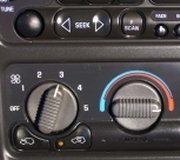There's two common causes of that. One is the cracked cam on the end of the lock cylinder I mentioned earlier, and the other is a defective neutral safety switch. Try cranking the engine in neutral, drive, and reverse. If it cranks in neutral, suspect the neutral safety switch. If it cranks in drive or reverse, suspect the shifter cable adjustment.
If that doesn't work, the starter system can be broken down into four circuits, and all of them have a convenient test point at the starter relay. Find that relay on the left inner fender somewhere behind the battery. It should have a fat brown wire, a fat red wire, and, as I recall, a pair of smaller yellow wires, and maybe a small black wire. Unplug that connector and use a test light or voltmeter to measure the voltages on the wires.
The ground clip for the test light or the black negative voltmeter lead must go to ground or the negative post of the battery. The red wire must have 12 volts all the time. One of the smaller wires must have 12 volts when you turn the ignition switch to "crank". If that one is missing, suspect the cam on the lock cylinder.
Move the ground clip for the light or the negative meter probe to the positive battery terminal. Now measure on the fat brown wire. If you read 12 volts or the test light lights up, the circuit is good through the starter solenoid. Measure the second smaller wire. The test light should light up or you'll have 12 volts, but it will go away when you shift out of park or neutral.
Find which one of those four circuits doesn't respond correctly. You can bypass testing the two larger wires by jumping them together momentarily with a piece of wire or a stretched-out cotter pin. Be sure the transmission is in park. If the starter cranks the engine, the red and brown circuits are okay. If the ignition switch is in the "run" position, the engine will start and run.
Wednesday, January 8th, 2014 AT 4:50 PM



